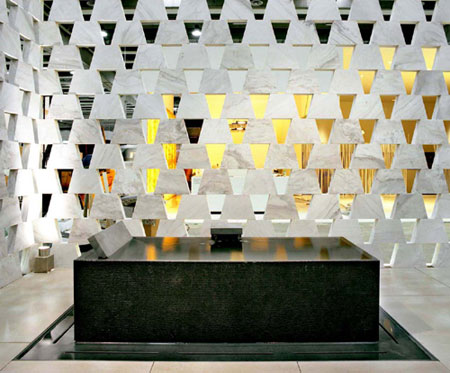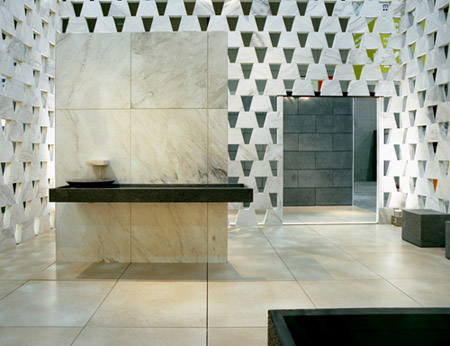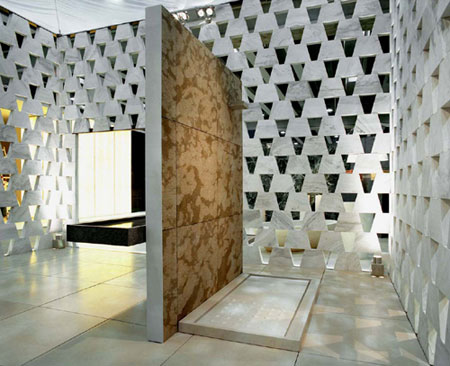24 Settembre 2008
English
Wabi-Sabi Stones

Kobe pool designed by Hikaru Mori for PIBA Marmi.
“In the occidental philosophical tradition, aesthetical issues have always been faced as secondary and less important in comparison to the bigger ethical question, the only one that forces the individual to his fundamental existential and religious choices. Art is no more than the visible reflection of morality, a testimony and a permanent link to it. Technique is an empty constructive activity that can be valued only in relationship with the “contents” justifying it.
(…) In Japan it’s the exact opposite: moral question consists in a very little part of the big “aesthetical question” of life. Evidence of the possible harmony between celestial and human world, Japanese people’s morality (especially in Shinto tradition) is expressed above all in beautifully shaping the world. They don’t try to find this kind of cosmic equilibrium in mega-structures, but in everyday experiences and in micro-systems: in domestic rituals precision, in private and public ceremonies perfection (…).
Our space conception is rational and restless, crystal clear (…); instead Japanese space conception is opaque, peaceful, humid as rice fields or reeds, it is based on floating foundations and looks at Nature and at its cycles as a part of its own history. (…) It’s in the design world that this Japanese latent “naturalism” gets very evident: hybrid, opaque, almost edible objects…”1
With these words contained in his recent essay, Andrea Banzi efficaciously describes a philosophical system, the latent and pervasive naturalism that characterizes Japanese culture and that is called Wabi-Sabi. This aesthetical approach towards reality, that also implies a precise lifestyle, has been reaching in these last years appreciation in Occidental tastes, making its way in our world and deeply changing our way to appreciate and think objects, to plan and live spaces.
Wabi-Sabi creates an equilibrium between human beings and Nature, based on intuitive sensations and proposed as a “soft” and wrapping formal world that needs a suffused, fading and elusive perception, a relaxing world apart made by tempting objects that wants to be in relationship with the viewers and to be approached and touched.
This naturalistic module gives prevalence to personal, private and intimate sphere rather than to the public one, and exalts everyday experiences, giving new meaning to simple domestic rituals and to body and mind care. This lifestyle practice needs a material culture that stimulates enrichment and expansion of visual, tactile, olfactory and auditory perceptions2. For this reason Wabi-Sabi surfaces are warm, opaque, rough, imperfect and they aren’t spoiled by material ageing, in the opposite their expressivity is enriched by contamination, oxidation and corrosion.
Wabi-Sabi materials are stone, wood, pottery, paper and natural fabrics; colours are dark, ground-like or volcanic, or light as hemp, silver or whitened greys, intermediary nuances between rust and mud.

Kyoto basin by Hikaru Mori in PIBA Marmi pavillion at 42nd Marmomacc exhibition in Verona.
[photogallery]piba_2_album[/photogallery]
In this material, cromatic and formal contest we can insert the three elements for bathroom furnishing designed by Hikaru Mori and produced by PIBA Marmi. Kobe pool, Kyoto basin and Osaka shower plate, conceived by the Japanese designer and manufactured by the company based in Chiampo, are the result of the contemporary conception of design objects, very far by now from the materialistic civilization formed in the Industrial Age and totally inserted in a renewed 3rd-millennium design world where manufacturing technologies cohabit with traditional knowledge of handmade objects, unique hors-sèries or limited edition pieces, diversified and personalized productions3.
Kobe pool, mainly addressed to professional use in spas or wellness centres, is made of Absolute Black marble with striped polishing on the outside surface and polished rough finish on the inside parts. The big recipient in shape of a parallelepiped is thought to let the water overflow and fall along the striped walls to the floor where it is collected in a tank and then re-sent to a recycle and depuration system. The numerous horizontal grooves on the outside stone surface amplify the visual effect of the liquid fall, while dark grey colour of the stone becomes intense black in contact with water.
Kyoto basin is as well produced in Absolute Black with polishing rough finish; water is initially collected in a low basin from which overflows gently sliding as a continuous veil on a slightly inclined plane that leads to a hidden drain.
Osaka shower plate is manufactured in milk-coloured Pietra di Fatima; water drain consists in lateral channels that flow together under the removable plate; on the plate surface, smooth reliefs produce plantar massages.
All the elements can be personalized in the choice of materials and dimensions and are conceived in function of their relationship with water: it constantly flows on their surfaces and becomes constituent part of their design. Liquid element changes from an only functional entity to an emotional presence that amplify stone perception, colours and frames, inviting to an active interaction with the object or to a contemplation aimed to global wellness.
Hikaru Mori got her inspiration from the reinterpretation of objects and rooms from thermal Japanese tradition and created in this way three innovative presences for the bathroom furnishing, that are natural in their materials and colours, essential and rigorous in their shapes, stimulating in their surfaces manufactured with the help of both advanced machinery and handmade sapient work; in Kobe, Osaka and Kyoto, stone is seen as a keeper of the world primitive energy and finds a renovated Wabi-Sabi equilibrium with purifying and regenerating water, primary source of life and of physical and spiritual reconciliation.

Osaka shower plate by Hikaru Mori for PIBA Marmi.
HIKARU MORI’S BIOGRAPHY
Born in Sapporo (Japan) in 1964, Hikaru Mori obtained an architecture degree in 1987 at Tokyo State University Geijytsu Daigaku where she also obtained, in 1991, a PhD. Then she moved to Milan in order to attend the specialization course on interior design at Design European Institute (IED); in the same city she began her professional activity in 1993, opening a studio and working both on architecture and on design.
From 1997 she teamed up with Maurizio Zito in the ZITO+MORI group that works on projecting architectural buildings, urban furnishings, geared gardens and installations.
Hikaru Mori designed Iota lamp collections for Nemo and created for Lucitalia “Adam”, an innovative system of multipurpose plates for ceilings, where different services and lightings of various morphology can be installed; among her main architectural creations we can remember the cellars for Fuedi company in San Gregorio (Avellino) and the Bisceglia cellar in Potenza4.
by Davide Turrini. Translation Paolo Armelli
Notes
1 Andrea Branzi, “Il naturalismo del dopo-Kobe”, Area n. 84, 2006, pp. 22-25.
2 About this point: Koren, Wabi-sabi per artisti, designer, poeti e filosofi, Firenze, Ponte alle Grazie, 2002, pp. 92, (tit. or. Wabi-sabi for artists, designers, poets and philosophers, 1994).
3 See the observations in Andrea Branzi, “Un museo diverso”, Interni n. 583, 2007, pp. 49-51.
4 For Hikaru Mori’s works: Stefano Casciani, “Se un giorno in primavera un avventore…”, Domus n. 880 – Speciale Convivialità, 2005, pp. 40-51; Maria Cristina Tommasini, “Calligrafia geometrica”, Domus n. 909, 2007, pp. 98-101; Vincenzo Pavan, Tre architetture con la pietra, Chiampo, PIBA Marmi, 2008, pp. 77.
